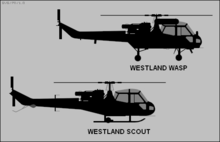Navalised aircraft
A navalised aircraft (or navalized aircraft) is an aircraft that has been specifically designed for naval use, in some cases as a variant of a land-based design. An aircraft based on an aircraft carrier is called carrier-based aircraft.

Characteristics
A navalised aircraft typically differs from its land-based equivalent by:
- The airframe, engine and avionics are marinised against salt water corrosion.
- It is designed to be used on a flight deck. For a fixed wing aircraft this typically means catapult attachment points, a tailhook and strengthened undercarriage. Naval helicopters usually have wheels rather than skids and may have mechanisms to attach to the deck.
- It is designed to occupy minimum hangar space – for example the wings, tail-boom or rotors may fold.
- There is enhanced protection against water ingress (including that from hosing down with fresh water to get rid of salt water).
- Equipment such as sensors and weapons are optimised for naval roles.
- The avionics is compatible with the complex electronic equipment of a warship, and that there is no electromagnetic interference between the two.
- There is provision for ditching at sea.
- Helicopters may have provision for receiving fuel through the cabin while hovering adjacent to a ship.
For safety reasons, the aviation fuel provided by ships may be different (e.g. AVCAT) from that provided by airfields and tanker aircraft.[1]
Examples
The T-45 Goshawk is a navalised version of the BAE Hawk jet trainer. Differences from the Hawk include changes to the undercarriage for aircraft carrier compatibility and a strengthened airframe. The engine design was also modified for the aircraft's role at sea.[2] A proposed navalised version of the Alpha Jet would have had similar design modifications.[3]
Other examples of navalised variants of land-based aircraft include:
- British Aerospace Sea Harrier
- Dassault Rafale M
- Hawker Sea Hurricane
- Mikoyan MiG-29K
- Supermarine Seafire
- Sikorsky SH-60 Seahawk
References
- Shell Fuels Technical Data Sheet - F-44
- naval-technology.com (accessed 16/10/2011)
- http://www.flightglobal.com/pdfarchive/view/1991/1991%20-%201042.html Flightglobal article from 1991